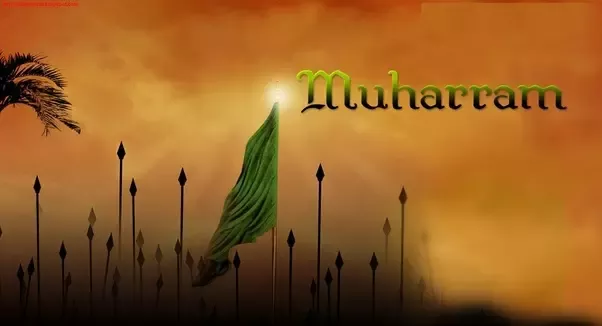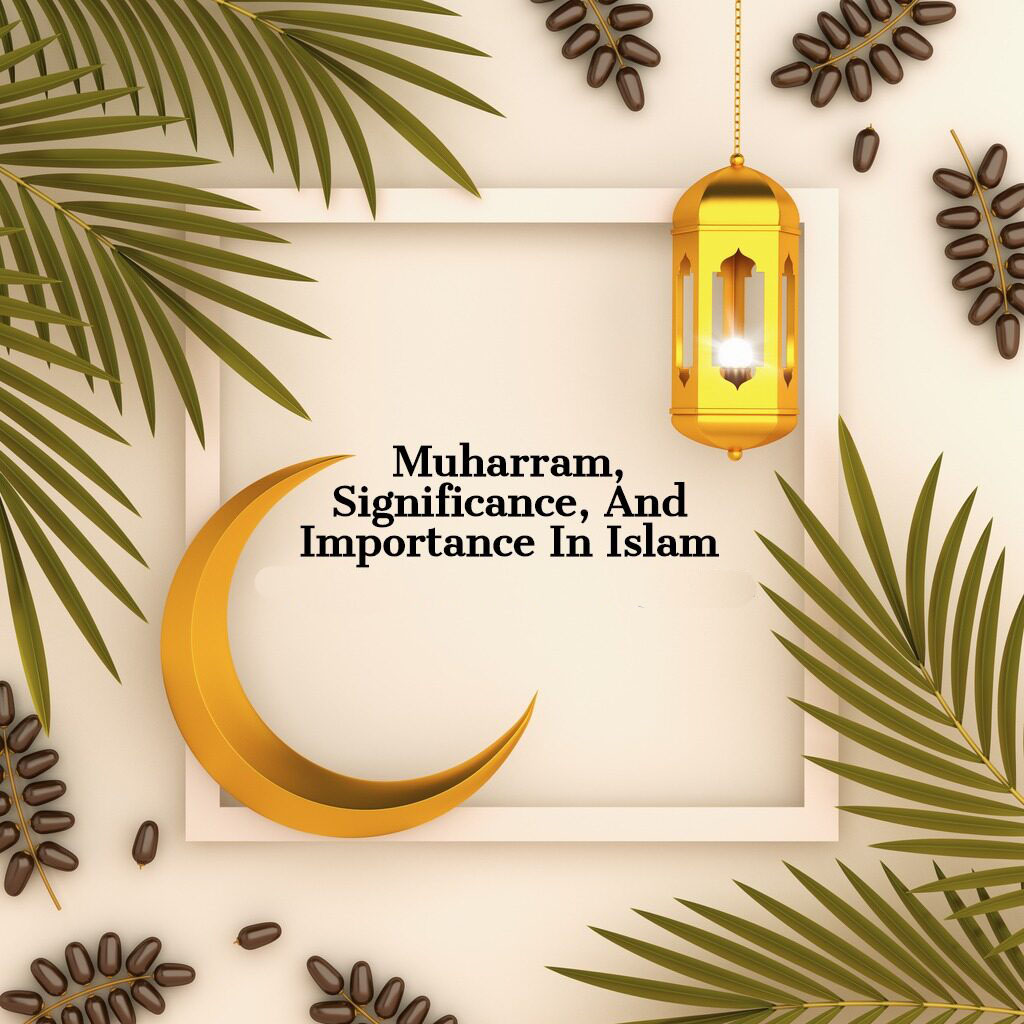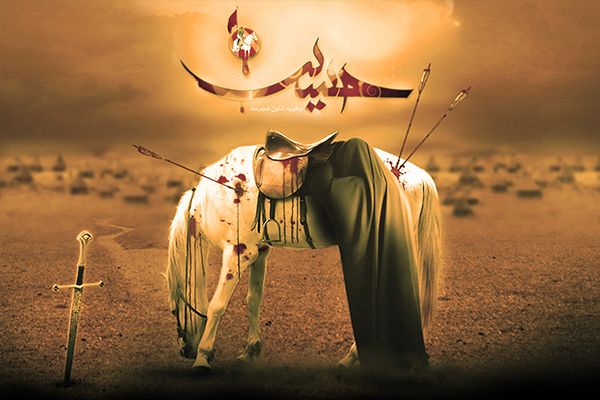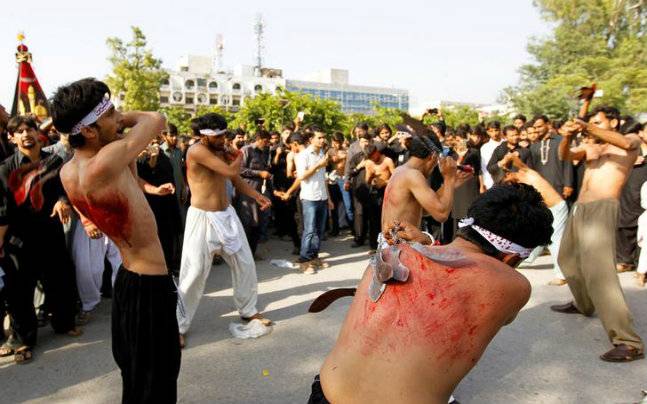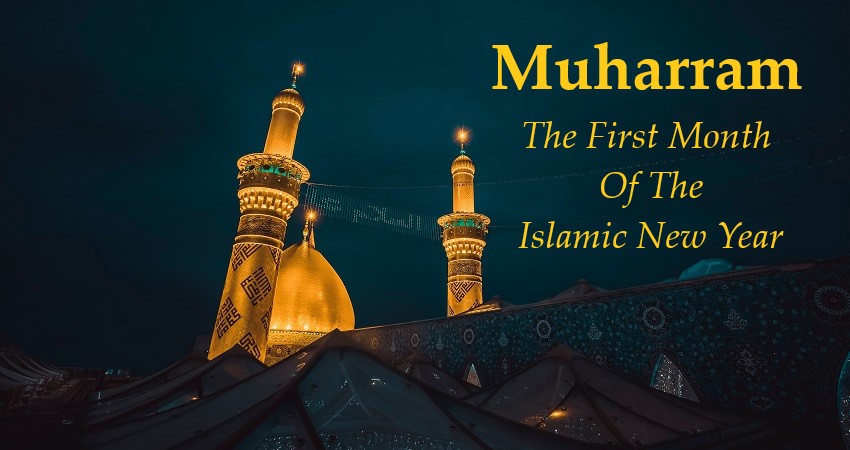Muharram is the first month of the Islamic lunar calendar and holds great significance for Muslims worldwide, particularly for the Shia Muslim community. It is a month of deep reflection, mourning, and remembrance. The word “Muharram” is derived from the Arabic word “haram,” which means “forbidden” or “sacred.”
Muharram marks the beginning of the Islamic New Year and is considered a month of mourning due to the tragic events that took place during this time in history, particularly the martyrdom of Imam Hussein, the grandson of Prophet Muhammad. The commemoration of these events holds immense religious and cultural importance for Muslims, serving as a time of reflection, spiritual growth, and solidarity.
Throughout Muharram, Muslims engage in various practices to honor the memory of Imam Hussein and express their grief over his martyrdom. These practices include processions, religious gatherings, fasting, recitation of elegies, and other rituals that are deeply rooted in Islamic tradition. The observance of Muharram varies across different regions and communities, but its central theme remains the remembrance of Imam Hussein’s sacrifice and the values he exemplified.
In this article, we will delve deeper into the significance of Muharram, explore how it is celebrated and observed, and understand why it holds such immense importance for Muslims worldwide. By gaining insight into the historical and cultural aspects of Muharram, we can appreciate the depth of emotions and reverence associated with this sacred month.
Table of Contents
Significance and Importance of Muharram
Muharram holds significant religious and historical importance for Muslims, especially for the Shia Muslim community. Understanding the significance of Muharram helps shed light on its observances and the emotions associated with this month of mourning. Here are some key points highlighting the importance of Muharram:
- Martyrdom of Imam Hussein: The primary significance of Muharram revolves around the martyrdom of Imam Hussein, the grandson of Prophet Muhammad, in the Battle of Karbala in 680 CE. Imam Hussein’s stand against injustice and tyranny, his unwavering commitment to the principles of Islam, and his sacrifice for truth and justice have become a symbol of courage, righteousness, and the struggle against oppression. Muharram serves as a time to commemorate and honor his martyrdom, keeping his spirit and teachings alive.
- Preservation of Islamic Principles: The events of Karbala represent a clash between the forces of good and evil. Imam Hussein’s refusal to pledge allegiance to the unjust ruler of his time, Yazid, was a statement against corruption and the deviation from Islamic principles. The commemoration of Muharram serves as a reminder for Muslims to uphold the values of justice, integrity, and resistance against oppression.
- Spiritual Reflection and Renewal: Muharram offers Muslims an opportunity for deep introspection and spiritual renewal. It encourages believers to reflect on their own lives, seek forgiveness, and make positive changes. The remembrance of Imam Hussein’s sacrifice and his unwavering faith inspires individuals to recommit themselves to the path of righteousness and to stand against injustice.
- Solidarity and Community Cohesion: Muharram is a time when Muslims come together as a community to mourn and remember the tragedy of Karbala. The collective grief and mourning processions foster a sense of unity, compassion, and empathy among believers. It is a time to support one another, strengthen communal bonds, and stand in solidarity with the oppressed.
- Lessons in Sacrifice and Selflessness: Imam Hussein’s sacrifice exemplifies the highest ideals of sacrifice, selflessness, and devotion to God. Muharram provides an opportunity for individuals to learn from his example and apply these values in their own lives. It teaches Muslims to prioritize justice, truth, and compassion, even in the face of adversity.
- Preservation of Islamic Heritage: Muharram serves as a means of preserving and passing on the historical and cultural heritage of Islam. Through the retelling of the events of Karbala, the recitation of elegies, and the sharing of narratives, Muslims ensure that future generations remain connected to their roots, history, and the enduring message of Islam.
Overall, Muharram holds immense significance as a month of remembrance, reflection, and inspiration for Muslims. It provides a platform to honor the sacrifice of Imam Hussein, reinforce the principles of Islam, and strengthen the bonds of community and solidarity. Through its observance, Muslims strive to emulate the values of justice, selflessness, and devotion to God in their own lives.
Historical Background of Muharram
To understand the historical background of Muharram, it is essential to explore the events that took place during the Battle of Karbala in 680 CE. This pivotal event has shaped the significance and observance of Muharram for Muslims around the world, particularly for the Shia Muslim community.
- Succession and Political Turmoil: Following the death of Prophet Muhammad in 632 CE, a succession dispute arose within the Muslim community regarding the leadership of the nascent Islamic state. This led to a division between those who believed that leadership should remain within the family of Prophet Muhammad (Ahl al-Bayt) and those who supported other candidates.
- Imam Hussein’s Stand: Imam Hussein, the son of Imam Ali (the cousin and son-in-law of Prophet Muhammad) and the grandson of Prophet Muhammad, refused to pledge allegiance to the Umayyad caliph, Yazid. He viewed Yazid’s leadership as unjust and incompatible with the principles of Islam. Imam Hussein’s decision to challenge Yazid’s authority marked the beginning of a significant uprising.
- The Journey to Karbala: Imam Hussein, along with his family and a small group of loyal companions, embarked on a journey from Medina to the city of Kufa in present-day Iraq. The people of Kufa had sent numerous letters to Imam Hussein, expressing their support and inviting him to lead them against the oppressive rule of Yazid. However, upon reaching Karbala, Imam Hussein encountered a betrayal. The people of Kufa did not provide the expected support, and the army of Yazid blocked their path, preventing access to necessary supplies such as water.
- The Battle of Karbala: On the 10th day of Muharram, known as the Day of Ashura, Imam Hussein and his small group of followers, numbering approximately 72 individuals, faced the overwhelming forces of Yazid’s army. Despite being vastly outnumbered and enduring extreme thirst and hunger, they refused to surrender. The battle resulted in the martyrdom of Imam Hussein, his companions, and several members of his family.
- Aftermath and Historical Impact: The aftermath of the Battle of Karbala was marked by immense grief and tragedy. The surviving family members of Imam Hussein, including his sister Zainab, were taken captive and led through various cities, where they courageously exposed the atrocities committed by Yazid’s forces. Their unwavering resolve and eloquent speeches in the courts of the caliphs played a crucial role in preserving the memory and significance of Karbala.
The events of Karbala and the martyrdom of Imam Hussein became a defining moment in Islamic history. The sacrifice and steadfastness of Imam Hussein and his companions came to symbolize the struggle against tyranny and the defense of truth and justice. The remembrance of these events during Muharram serves as a testament to the enduring legacy of Imam Hussein and a reminder of the importance of upholding moral principles in the face of adversity.
Observances and Rituals during Muharram
Muharram is a month of deep mourning and reflection, characterized by various observances and rituals that hold immense significance for Muslims, especially the Shia Muslim community. These practices aim to honor the memory of Imam Hussein and express grief over his martyrdom. While the specific customs may vary across regions and communities, here are some common observances and rituals during Muharram:
A. The Mourning Processions (Tazia Processions):
Muharram is marked by solemn processions known as Tazia processions. These processions involve participants, often dressed in black, walking through the streets while carrying replicas of the mausoleums of Imam Hussein and his companions. The processions are accompanied by recitations of elegies (Marsiya) and chants mourning the tragedy of Karbala. These processions serve as a collective expression of grief and solidarity.
B. Majlis and Mourning Gatherings:
Majlis refers to religious gatherings held during Muharram where believers come together to mourn and commemorate the martyrdom of Imam Hussein. These gatherings often take place in mosques or special spaces designated for Muharram. Scholars and orators deliver sermons and speeches recounting the events of Karbala, emphasizing the principles of justice, sacrifice, and devotion to God. The recitation of elegies, poems, and narrations highlighting the suffering and martyrdom of Imam Hussein is a central feature of these gatherings.
C. Fasting on the Day of Ashura:
Fasting on the 10th day of Muharram, known as the Day of Ashura, is a common practice among Muslims, both Shia and Sunni. It is believed that fasting on this day serves as a means of expressing solidarity with Imam Hussein and his family, who endured hunger and thirst during the Battle of Karbala. Some individuals may choose to fast for the entire month of Muharram or specifically on the Day of Ashura.
D. Recitation of Marsiya and Noha:
Marsiya and Noha are poetic expressions of sorrow and lamentation recited or sung during Muharram. Marsiya refers to elegiac poetry that recounts the events of Karbala and Imam Hussein’s martyrdom, often invoking deep emotions of grief and sadness. Noha, on the other hand, focuses on the tragedy of Karbala and the suffering endured by Imam Hussein’s family and companions. The recitation of Marsiya and Noha serves to keep alive the memory of Karbala and evoke a sense of empathy and sorrow among the listeners.
E. Self-flagellation (Matam) and Chest-beating (Sine Zani):
Some individuals engage in acts of self-flagellation and chest-beating as a way to express their grief and mourning for the tragedy of Karbala. This practice, known as Matam or Azadari, involves striking one’s chest with the hands or using special implements like chains or blades. It is considered a physical manifestation of the pain and anguish felt over the martyrdom of Imam Hussein and his companions. While this practice is not universal and is not endorsed by all scholars, it holds cultural significance for some communities during Muharram.
These observances and rituals during Muharram serve as a means for believers to remember and commemorate the sacrifice of Imam Hussein and his companions. They provide avenues for expressing grief, reflecting on the values of justice and selflessness, and strengthening the bond of community and solidarity. While the rituals may vary, the underlying purpose remains the same: to honor the memory of Imam Hussein and draw inspiration from his legacy.
Commemoration of Imam Hussein’s Martyrdom
The martyrdom of Imam Hussein in the Battle of Karbala is a central event commemorated during Muharram. The commemoration serves as a time for Muslims, particularly the Shia Muslim community, to remember and reflect upon the sacrifice and principles exemplified by Imam Hussein. Here are key aspects related to the commemoration of Imam Hussein’s martyrdom:
A. Battle of Karbala:
The Battle of Karbala, which took place on the 10th day of Muharram in 680 CE, was a significant event in Islamic history. Imam Hussein, along with a small group of his family members and companions, faced the oppressive forces of Yazid’s army. Despite being vastly outnumbered, Imam Hussein and his followers demonstrated unwavering faith, courage, and refusal to submit to injustice. The battle resulted in the martyrdom of Imam Hussein, his companions, and members of his family.
B. Story of Imam Hussein and his Martyrdom:
During the commemoration of Muharram, the story of Imam Hussein and the events leading to his martyrdom is retold and passed down through generations. The narrative highlights the bravery, principles, and sacrifices of Imam Hussein and his loyal companions. It emphasizes the struggle against oppression, the pursuit of justice, and the ultimate price paid for upholding the principles of Islam.
C. Lessons and Teachings from Imam Hussein’s Sacrifice:
The commemoration of Imam Hussein’s martyrdom offers an opportunity for individuals to reflect upon the lessons and teachings derived from his sacrifice. It serves as a reminder of the importance of standing up against injustice, defending truth, and upholding moral values even in the face of adversity. The principles of justice, selflessness, and devotion to God that Imam Hussein exemplified are contemplated and internalized as guiding principles in the lives of believers.
D. Emotional Mourning and Lamentation:
The commemoration of Imam Hussein’s martyrdom is accompanied by a deep expression of grief and mourning. It is a time for individuals to connect with the emotional and spiritual aspects of the tragedy of Karbala. The recitation of elegies (Marsiya) and mourning poems (Noha) evokes a sense of sorrow and empathy, allowing believers to collectively mourn the loss and suffering endured by Imam Hussein and his family.
E. Processions and Mourning Rituals:
Mourning processions, known as Tazia processions, are an integral part of commemorating Imam Hussein’s martyrdom. Participants, often dressed in black, walk in solemn processions while carrying replicas of the mausoleums of Imam Hussein and his companions. These processions symbolize a collective expression of grief and remembrance. Some individuals may engage in acts of self-flagellation (Matam) or chest-beating (Sine Zani) as a physical manifestation of their sorrow and mourning.
F. Symbolic Commemoration:
The commemoration of Imam Hussein’s martyrdom goes beyond mourning and remembrance. It serves as a symbolic representation of the ongoing struggle for justice, freedom, and human rights. The events of Karbala become a universal symbol of resistance against oppression and a reminder of the need to stand against tyranny in all its forms.
The commemoration of Imam Hussein’s martyrdom during Muharram is a profound and emotionally charged period for Muslims. It offers an opportunity to reflect upon the values and principles upheld by Imam Hussein, to mourn his tragic loss, and to renew the commitment to justice, righteousness, and selflessness in one’s own life.
The Role of Muharram in Shia Islam
Muharram holds a distinct and significant role in Shia Islam. It is a month of deep religious observance and mourning, particularly for Shia Muslims, who commemorate the martyrdom of Imam Hussein and his companions during the events of Karbala. Here are key aspects highlighting the role of Muharram in Shia Islam:
A. Reverence for Imam Hussein:
Imam Hussein, the grandson of Prophet Muhammad, is highly revered in Shia Islam. His martyrdom is considered a defining moment in the struggle for justice and the preservation of Islamic principles. Muharram serves as a period to honor and remember Imam Hussein’s sacrifice, as well as his unwavering commitment to truth and righteousness.
B. Spiritual Reflection and Self-Purification:
Muharram provides Shia Muslims with a time for deep spiritual reflection and self-purification. It is an opportunity to introspect, seek forgiveness, and make positive changes in one’s life. The remembrance of Imam Hussein’s sacrifice inspires believers to renew their commitment to the values of justice, selflessness, and devotion to God.
C. Commemoration of Karbala:
The commemoration of Karbala and Imam Hussein’s martyrdom is a central aspect of Muharram for Shia Muslims. The retelling of the events of Karbala, the recitation of elegies and mourning poems, and the participation in processions and gatherings allow believers to mourn the tragedy, express grief, and remember the suffering endured by Imam Hussein and his family.
D. Symbol of Resistance and Struggle:
The events of Karbala serve as a powerful symbol of resistance and struggle against oppression in Shia Islam. Imam Hussein’s refusal to submit to an unjust ruler, his stand against tyranny, and his sacrifice for the principles of Islam have become enduring symbols of courage, resilience, and the fight against injustice. Muharram reinforces the importance of standing up for justice and defending truth, even in the face of adversity.
E. Solidarity and Community Bonding:
Muharram fosters a sense of unity, solidarity, and communal bonding among Shia Muslims. The shared grief and mourning over Imam Hussein’s martyrdom create a strong bond that transcends geographical boundaries and brings believers together. Mourning processions, Majlis gatherings, and participation in communal rituals during Muharram strengthen the sense of belonging and foster a collective spirit of support and empathy.
F. Educational and Didactic Role:
Muharram serves as an educational and didactic period in Shia Islam. The sermons, speeches, and discussions held during Majlis gatherings provide opportunities for religious scholars and orators to impart knowledge about the life, principles, and teachings of Imam Hussein. These sessions aim to enlighten believers about the importance of justice, sacrifice, and the need to resist oppression.
G. Cultural Preservation:
Muharram plays a vital role in preserving Shia Islamic culture and traditions. The observances and rituals associated with Muharram, such as the recitation of elegies, the performance of passion plays (Ta’ziya), and the creation of replicas of the mausoleums of Karbala, are cultural practices that have been passed down through generations. These practices help maintain a strong sense of cultural identity and historical continuity among Shia communities.
In Shia Islam, Muharram holds a central place as a month of deep mourning, remembrance, and spiritual reflection. It serves as a time to honor Imam Hussein’s sacrifice, reinforce the principles of justice and resistance against oppression, and strengthen the bonds of solidarity within the Shia community. Muharram is a period of immense religious devotion and cultural significance for Shia Muslims worldwide.
Muharram Celebrations in Different Regions
Muharram, the first month of the Islamic calendar, is observed with varying traditions and customs in different regions across the world. While the commemoration of Imam Hussein’s martyrdom remains central, the specific practices and expressions of mourning may vary based on local cultures and traditions. Here are some notable Muharram celebrations in different regions:
A. South Asia:
- Majlis and Juloos: In countries like India and Pakistan, Muharram is marked by large processions called Juloos. Participants, often dressed in black, march through the streets while reciting Noha and Marsiya. Majlis gatherings are held where religious scholars deliver sermons highlighting the significance of Karbala and Imam Hussein’s sacrifice.
- Matam and Zanjeer Zani: Some communities in South Asia engage in acts of self-flagellation (Matam) and chest-beating (Zanjeer Zani) as a form of mourning during Muharram. This practice is particularly prevalent in Shia communities, where participants express their grief and solidarity with Imam Hussein.
B. Middle East:
- Processions and Taziya: In countries like Iran, Iraq, and Lebanon, Muharram processions are a common sight. Participants march through the streets, carrying Taziya or miniature replicas of the mausoleums of Imam Hussein and his companions. These processions often involve theatrical performances and reenactments of the events of Karbala.
- Ta’ziya and Rawda Khwani: Ta’ziya refers to passion plays that depict the tragedy of Karbala. Actors portray the various characters, including Imam Hussein and Yazid, in theatrical performances held in specially constructed stages or tents. Rawda Khwani involves reciting Marsiya and elegies in gatherings to mourn the martyrdom of Imam Hussein.
C. Africa:
- Processions and Mourning Gatherings: In countries like Egypt, Nigeria, and Tanzania, Muharram is marked by processions and mourning gatherings. Participants, often dressed in black, march through the streets, carrying banners and flags with religious symbols. Majlis gatherings are held, where religious leaders deliver sermons and recite Marsiya.
D. Western Countries:
- Commemorative Gatherings: In Western countries with Muslim communities, Muharram is observed through commemorative gatherings held in mosques, Islamic centers, or community halls. These gatherings involve lectures, discussions, and recitations that focus on the events of Karbala and the lessons derived from Imam Hussein’s sacrifice.
- Interfaith Dialogues: Some communities organize interfaith dialogues and events during Muharram to promote understanding and foster dialogue between different religious communities. These events provide an opportunity for individuals from diverse backgrounds to learn about the significance of Muharram and its teachings.
While these examples highlight some common Muharram celebrations in different regions, it’s important to note that practices can vary within and across countries. The essence of Muharram, however, remains consistent – to honor the memory of Imam Hussein, commemorate the tragedy of Karbala, and reflect upon the values of justice, sacrifice, and standing against oppression.
Muharram and Interfaith Relations
Muharram, with its rich history and profound significance in Islamic tradition, can also play a role in fostering interfaith relations and promoting understanding among different religious communities. Here are some ways in which Muharram can contribute to interfaith dialogue and relations:
- Education and Awareness: Muharram presents an opportunity to educate individuals from different faiths about its significance and the events of Karbala. By organizing educational sessions, lectures, or seminars, communities can share information about Imam Hussein, the principles he stood for, and the impact of his martyrdom. Such initiatives can help dispel misconceptions and promote better understanding of Shia Islamic practices.
- Open House Events: Organizing open house events during Muharram can invite members of other faith communities to visit mosques or Islamic centers and participate in the commemorative rituals. These events can provide a platform for dialogue, where participants can ask questions, engage in discussions, and learn more about the historical and religious aspects of Muharram. It fosters a sense of inclusivity and promotes interfaith harmony.
- Interfaith Gatherings and Dialogues: Interfaith gatherings and dialogues specifically focused on Muharram can bring together individuals from diverse religious backgrounds. Participants can engage in conversations about the lessons and values derived from the tragedy of Karbala, such as justice, sacrifice, and empathy. Such dialogues can help foster mutual respect, build bridges, and strengthen interfaith relations.
- Joint Commemorations: In some cases, interfaith communities may choose to hold joint commemorations of Muharram, where individuals from different faiths come together to observe and understand the rituals associated with the month. This shared experience can promote dialogue, create bonds of solidarity, and deepen mutual appreciation for each other’s religious practices.
- Volunteer and Service Activities: Muharram is also a time of giving and service in many communities. Engaging in volunteer activities, such as organizing food drives, blood donation camps, or charity initiatives during Muharram, can serve as a means of collaborative action between individuals of different faiths. Such joint efforts can strengthen relationships and promote the common values of compassion and helping those in need.
- Respectful Observance: For individuals of other faiths, showing respect and sensitivity towards the observance of Muharram is essential. This can include refraining from scheduling conflicting events or gatherings during Muharram, being mindful of the somber nature of the month, and expressing condolences and support to Muslim friends or colleagues observing Muharram.
Muharram, with its themes of justice, sacrifice, and standing against oppression, can serve as a point of connection and understanding among people of different faiths. By embracing opportunities for interfaith dialogue, education, and shared experiences, Muharram can contribute to building bridges of understanding, respect, and collaboration between religious communities.
Muharram in the Modern Context
Muharram, with its historical and religious significance, continues to hold relevance in the modern context. While the core observances remain consistent, the way Muharram is celebrated and its impact on society have evolved with changing times. Here are some aspects highlighting Muharram’s relevance in the modern context:
- Social Justice and Activism: Muharram’s emphasis on justice and resistance against oppression resonates with contemporary social justice movements. In the modern context, Muharram can serve as a reminder of the ongoing struggle for equality, human rights, and dignity. It can inspire individuals to engage in activism, speak out against injustices, and work towards positive societal change.
- Unity and Solidarity: Muharram provides an opportunity for communities to come together and foster unity and solidarity. In a world often divided along religious, cultural, and social lines, Muharram can serve as a unifying force, bringing people from diverse backgrounds together to mourn the tragedy of Karbala and reflect on shared values of compassion, justice, and empathy.
- Tolerance and Mutual Respect: In an era marked by religious pluralism and multiculturalism, Muharram encourages the practice of tolerance and mutual respect. It invites individuals of different faiths to learn about and appreciate the religious customs and traditions associated with Muharram. By engaging in interfaith dialogue and fostering understanding, Muharram contributes to creating a more inclusive and harmonious society.
- Historical Reflection and Learning: Muharram offers an opportunity for historical reflection and learning. In the modern context, it is essential to revisit the events of Karbala and understand their relevance in today’s world. By studying the lessons from Imam Hussein’s sacrifice, individuals can draw inspiration and apply those teachings to their personal and societal lives.
- Ethical and Moral Values: Muharram underscores the importance of ethical and moral values. It serves as a reminder of the significance of honesty, integrity, and compassion in navigating contemporary challenges. Muharram can inspire individuals to uphold these values in their personal and professional lives, fostering a more ethical and just society.
- Peaceful Coexistence: Muharram promotes the idea of peaceful coexistence and respect for religious diversity. In the modern context, it is crucial to cultivate an atmosphere of understanding and acceptance among different religious communities. By engaging in dialogue, participating in interfaith events, and demonstrating solidarity, Muharram can contribute to building bridges and nurturing peaceful relationships.
- Cultural Preservation: Muharram plays a role in preserving cultural heritage. The rituals, poetry, music, and artistic expressions associated with Muharram are an integral part of the cultural identity of many communities. By safeguarding and celebrating these cultural elements, Muharram contributes to the richness and diversity of societies.
In the modern context, Muharram serves as a source of inspiration, social engagement, and cultural preservation. It encourages individuals to reflect on timeless values, engage in social justice activism, foster interfaith dialogue, and promote peace and unity. By embracing the teachings and spirit of Muharram, communities can contribute to a more compassionate, just, and harmonious world.
Conclusion: Reflecting on the Significance of Muharram
Muharram, the first month of the Islamic calendar, holds immense significance for Muslims, particularly Shia Muslims, worldwide. It is a month of deep reflection, mourning, and commemoration of the martyrdom of Imam Hussein and his companions in the tragic events of Karbala. Throughout history, Muharram has served as a symbol of resistance against oppression, a reminder of the pursuit of justice, and a call to uphold the principles of Islam.
The observance of Muharram allows individuals to connect with the legacy of Imam Hussein, drawing inspiration from his unwavering commitment to truth, justice, and standing against tyranny. It fosters self-reflection, self-purification, and renewal of one’s faith and commitment to God.
Muharram also plays a significant role in interfaith relations, providing an avenue for dialogue, understanding, and the promotion of mutual respect among different religious communities. Through educational initiatives, open house events, and interfaith gatherings, Muharram becomes a platform for sharing knowledge, dispelling misconceptions, and fostering harmony.
In the modern context, Muharram continues to hold relevance as a catalyst for social justice, activism, and the pursuit of peace. It inspires individuals to advocate for equality, to raise their voices against injustice, and to work towards creating a more compassionate and inclusive society.
Furthermore, Muharram serves as a cultural touchstone, preserving traditions, rituals, and artistic expressions that have been passed down through generations. It contributes to the richness and diversity of human heritage, highlighting the importance of cultural preservation and celebration.
As we reflect on the significance of Muharram, let us remember the lessons of Imam Hussein’s sacrifice: the unyielding pursuit of justice, the resistance against oppression, and the importance of compassion, unity, and peace. May Muharram serve as a reminder to all of us to strive for a world guided by these values, where justice prevails and humanity stands united.

